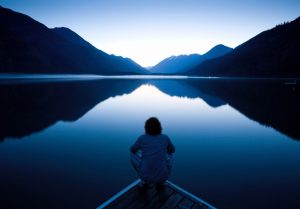 Part 5 of 5
Part 5 of 5
Why is it that whenever someone catches us doing nothing, we immediately jump to our feet so that we’re not perceived as total time-wasting deadbeats? If that is something you can relate to, here’s a radical idea for your mind to chew on:
Doing nothing is a legitimate a state of being.
If you’re a big doing-machine like most people, my guess is that this idea isn’t going to sit well. Especially if you live in the West where all accomplishment and achievement is measured by how well we “do.”
Non-doing is like a big empty hall that you hang out in for a while. Doesn’t sound all that inviting, I know. But here’s the thing as I’ve experienced it: Practicing doing nothing for a few minutes every day opens us up to a whole new side of ourselves that we didn’t know was there – a yummy spaciousness, a quiet stillness, a deep peace – which expands and grows. Like the practices I outlined in my previous four posts, it also works wonders to ease the side-effects of clearing clutter.*
The list below will help you cultivate non-doing. It is excerpted from a blog post called “The Art of Doing Nothing” by Leo Babauta (the Zen Habits guy):
Shut off all distractions — TV, computer, cell phones, regular phones, and the like. Doing nothing is hard when our communications gadgets are calling at us to do something. Now, close your eyes, and do nothing.
Breathe: Start first by breathing slowly in, and then slowly out. Now closely monitor your breath as it enters your body, through your nose, and goes down into your lungs, and fills your lungs. Now feel it as it goes out of your body, through your mouth, and feel the satisfying emptying of your lungs.
Relax: An important part of doing nothing is being able to completely relax. If we are tense, then the doing of the nothing is really for naught. Relaxing starts by finding a comfortable place to do your nothing — a soft chair, a plush couch, a well-made, clean bed. Once you’ve found this spot, lie in it, and wiggle around to make it fit your body better.
Soak in a tub: Step into your bath, one foot at a time, very slowly. If your bath is properly hot, it is best if you get into it an inch at a time…squeeze your eyes shut tight and slowly lower yourself into the steaming water despite all instincts to flee. Once you are fully immersed (and you should go completely under, head included, at first), close your eyes, and feel the heat penetrating your body. You may begin to sweat. This is a good thing. Allow the sweat to flow. You may need a glass of water as the sweat could dehydrate you…Allow your muscles to be penetrated by the heat, to be relaxed completely, and feel all your worries and stresses and aches and inner turmoil flow out of your body into the water. [See my post: “Soak in Salt and Soda” to nourish your experience of bathing even more.]
Taste and Feel: Doing nothing is also great when accompanied by very good beverages or food. Good tea or coffee, wine, hot cocoa, and other sensual beverages go very well with the Art. It’s best to take these beverages by themselves, with no food, and without a book or other distractions. Focus on the liquid as you sip it slowly, savoring every bit of the flavor and texture and temperature in your mouth before swallowing, and feeling the swallow completely. Close your eyes as you do this. Truly enjoy this drink.
Do nothing in nature: Once you’ve passed the above stages, it is time to practice this gentle art out in nature. Find a peaceful place — in your front yard if that’s peaceful, a park, the woods, at the beach, a river, a lake — places with water are excellent. Places out of reach of the sounds of traffic and city life are best.
Do nothing in daily life: …Start by doing nothing while you are waiting in line, at the doctor’s office, on a bus, or for a plane. Wait, without reading a newspaper or magazine, without talking on the phone, without checking your email, without writing out your to-do list, without doing any work, without worrying about what you need to do later. Wait, and do nothing. Concentrate on your breathing, or try one of the relaxation techniques above. Concentrate on those around you — watch them, try to understand them, listen to their conversations…”
— Excerpted [and paraphrased in part by me] from “The Art of Dong Nothing,” by Leo Babauta, ZenHabits.net. Read full post
One final goodie from me to add to the list above is The Floor Pose. Practicing this simple yoga pose supports you in letting go completely and it helps charm the mind away from the need to “do.”
So what do you think? Which one of these practices helps you cultivate stillness?
*This is the final installment in a five-part series on easing the side-effects of clutter clearing. Here are the other posts and their sequence to help you support a successful clearing practice:
-
[…] Next up: “Do Nothing: Reflections on the Art of Non-Doing.” […]
[…] Do Nothing: Reflections on the Art of Non-Doing […]
[…] Do Nothing: Reflections on the Art of Non-Doing […]
Leave a Comment





I love your website.
Thank you, Luz. I appreciate your comment!
I love your sayings….Marnie ryan